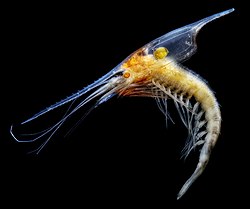zoëa
Appearance
See also: zoea
English
[edit]
Alternative forms
[edit]Etymology
[edit]From New Latin zōaea, zōēa, from Ancient Greek ζωή (zōḗ, “life”) (compare ζῷον (zôion)).
Pronunciation
[edit]Noun
[edit]- (zoology) A larval stage of certain decapod crustaceans, especially of decapods such as crabs and certain Anomura, also called the copepod stage, characterized by spines on the carapace and rudimentary thoracic and abdominal limbs.
Usage notes
[edit]- In this stage the anterior part of the body is relatively large, and usually bears three or four long spines. The years are conspicuous, and the antennae and jaws are long, fringed organs used in swimming. The thoracic legs are undeveloped or rudimentary, the abdomen long, slender, and often without appendages. The zoëa, after casting its shell, changes to a megalops. This was originally thought to be a distinct genus.
Translations
[edit]References
[edit]- “zoëa”, in Webster’s Revised Unabridged Dictionary, Springfield, Mass.: G. & C. Merriam, 1913, →OCLC.
- William Dwight Whitney and Benjamin E[li] Smith, editors (1914), “zoëa”, in The Century Dictionary: An Encyclopedic Lexicon of the English Language, revised edition, volumes V (Simular–Z), New York, N.Y.: The Century Co., →OCLC.
- “zoëa”, in Merriam-Webster Online Dictionary, Springfield, Mass.: Merriam-Webster, 1996–present.
Categories:
- English terms borrowed from New Latin
- English terms derived from New Latin
- English terms derived from Ancient Greek
- English 3-syllable words
- English terms with IPA pronunciation
- English lemmas
- English nouns
- English countable nouns
- English nouns with irregular plurals
- English terms spelled with Ë
- English terms spelled with ◌̈
- en:Zoology
- en:Baby animals
- en:Crustaceans
